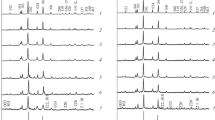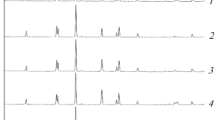Abstract—
Na1 + 2xZnxZr2 – x(PO4)3 phosphates have been prepared by a sol–gel process followed by heat treatment. A limited series (0 ≤ x ≤ 0.4) of solid solutions with the NASICON structure has been obtained in the system studied. The crystal structure of Na1.8Zn0.4Zr1.6(PO4)3 has been refined by the Rietveld method. The results demonstrate that the structural basis of this phosphate has the form of a mixed framework made up of corner-sharing (Zr/Zn)O6 octahedra and PO4 tetrahedra. The Na+ ions partially occupy two types of structural voids. The sodium ion conductivity of the Na1 + 2xZnxZr2 – x(PO4)3 phosphates has been studied using impedance spectroscopy. Their conductivity has been shown to increase with increasing carrier concentration, reaching 2.7 × 10–4 S/cm at 723 K in the case of Na1.8Zn0.4Zr1.6(PO4)3. It has been shown that increasing the degree of zinc substitution for zirconium leads to a change in the mechanism of defect formation in the materials studied: from intrinsic disorder at x = 0 to impurity-related disorder for x > 0.2. We have estimated the enthalpy of intrinsic sodium ion disorder (72 kJ/mol) and the activation energy for sodium migration (61 kJ/mol).



Similar content being viewed by others
REFERENCES
Naqash, S., Ma, Q., Tietz, F., and Guillon, O., Na3Zr2(SiO4)2(PO4) prepared by a solution-assisted solid state reaction, Solid State Ionics, 2017, vol. 302, pp. 83–91.https://doi.org/10.1016/j.ssi.2016.11.004
Park, H., Jung, K., Nezafati, M., Kim, C.S., and Kang, B., Sodium ion diffusion in Nasicon (Na3Zr2Si2PO12) solid electrolytes: effects of excess sodium, ACS Appl. Mater. Interfaces, 2016, vol. 8, no. 41, pp. 27814–27824.https://doi.org/10.1021/acsami.6b09992
Goodenough, J.B., Hong, H.Y.-P., and Kafalas, J.A., Fast Na+-ion transport in skeleton structures, Mater. Res Bull., 1976, vol. 11, pp. 203–220.https://doi.org/10.1016/0025-5408(76)90077-5
Pet’kov, V.I., Shipilov, A.S., Borovikova, E.Yu., Stenina, I.A., and Yaroslavtsev, A.B., Synthesis and ionic conductivity of NaZr2(AsO4)x(PO4)3 – x , Russ. J. Electrochem., 2019, vol. 55, no. 10, pp. 1034–1038.
Sukhanov, M.V., Ermilova, M.M., Orekhova, N.V., Pet’kov, V.I., and Tereshchenko, G.F., Catalytic properties of zirconium phosphate and double phosphates of zirconium and alkali metals with a NaZr2(PO4)3 structure, Russ. J. Appl. Chem., 2006, vol. 79, no. 4, pp. 614–618.
Pet’kov, V.I. and Asabina, E.A., Thermophysical properties of NZP ceramics (a review), Glass Ceram., 2004, vol. 61, nos. 7–8, pp. 233–239.
Pilonen, P.C., Friis, H., Rowe, R., and Poirier, G., Crystal structure determination of kosnarite, KZr2(PO4)3, from the Mario Pinto Mine, Jenipapo district, Itinga, Brazil, Can. Mineral., 2020, vol. 58, pp. 1–16.https://doi.org/10.3749/canmin.2000044
Schlem, R., Till, P., Weiss, M., Krauskopf, T., Culver, S.P., and Zeier, W.G., Ionic conductivity of the NASICON-related thiophosphate Na1 + xTi2 – xGax(PS4)3, Chem. – Eur. J., 2019, vol. 25, pp. 4143–4148.https://doi.org/10.1002/chem.201805569
Das, A., Krishna, P.S.R., Goswami, M., and Krishnan, M., Structural analysis of Al and Si substituted lithium germanium phosphate glass-ceramics using neutron and X-ray diffraction, J. Solid State Chem., 2019, vol. 271, pp. 74–80.https://doi.org/10.1016/j.jssc.2018.12.038
Yaroslavtsev, A.B., Solid electrolytes: main prospects of research and development, Usp. Khim., 2016, vol. 85, no. 11, pp. 1255–1276.
Tiliakos, A., Iordache, M., and Marinoiu, A., Ionic conductivity and dielectric relaxation of NASICON superionic conductors at the near-cryogenic regime, Appl. Sci., 2021, vol. 11, paper 8432.https://doi.org/10.3390/app11188432
Noguchi, Y., Kobayashi, E., Plashnitsa, L.S., Okada, S., and Yamaki, J.I., Fabrication and performances of all solid-state symmetric sodium battery based on NASICON-related compounds, Electrochim. Acta, 2013, vol. 101, pp. 59–65.https://doi.org/10.1016/j.electacta.2012.11.038
Lalère, F., Leriche, J.B., Courty, M., Boulineau, S., Viallet, V., Masquelier, C., and Seznec, V., An all-solid state NASICON sodium battery operating at 200°C, J. Power Sources, 2014, vol. 247, pp 975–980.https://doi.org/10.1016/j.jpowsour.2013.09.051
Stenina, I.A. and Yaroslavtsev, A.B., Nanomaterials for lithium-ion batteries and hydrogen energy, Pure Appl. Chem., 2017, vol. 89, no. 8, pp. 1185–1194.https://doi.org/10.1515/pac-2016-1204
Novikova, S.A., Larkovich, R.V., Chekannikov, A.A., Kulova, T.L., Skundin, A.M., and Yaroslavtsev, A.B., Electrical conductivity and electrochemical characteristics of Na3V2(PO4)3-based NASICON-type materials, Inorg. Mater., 2018, vol. 54, no. 8, pp. 839–849.
Zhao, C., Liu, L., Qi, X., Lu, Y., Wu, F., Zhao, J., Yu, Y., Hu, Y.S., and Chen, L., Solid-state sodium batteries, Adv. Energy Mater., 2018, vol. 8, paper 1703012.https://doi.org/10.1002/aenm.201703012
Ruan, Y., Guo, F., Liu, J., Song, S., Jiang, N., and Cheng, B., Optimization of Na3Zr2Si2PO12 ceramic electrolyte and interface for high performance solid-state sodium battery, Ceram. Int., 2019, vol. 45, pp. 1770–1776.https://doi.org/10.1016/j.ceramint.2018.10.062
Wang, Y., Song, S., Xu, C., Hu, N., Molenda, J., and Lu, L., Development of solid-state electrolytes for sodium-ion battery—a short review, Nano Mater. Sci., 2019, vol. 1, pp. 91–100.https://doi.org/10.1016/j.nanoms.2019.02.007
Guin, M., Tietz, F., and Guillon, O., New promising NASICON material as solid electrolyte for sodium-ion batteries: correlation between composition, crystal structure and ionic conductivity of Na3 + xSc2SixP3 – xO12, Solid State Ionics, 2016, vol. 293, pp. 18–26.https://doi.org/10.1016/j.ssi.2016.06.005
Naqash, S., Tietz, F., Yazhenskikh, E., Müller, M., and Guillon, O., Impact of sodium excess on electrical conductivity of Na3Zr2Si2PO12 + xNa2O ceramics, Solid State Ionics, 2019, vol. 336, pp. 57–66.https://doi.org/10.1016/j.ssi.2019.03.017
Arbi, K., Jimenez, R., Salkus, T., Orliukas, A.F., and Sanz, J., On the influence of the cation vacancy on lithium conductivity of Li1 + xRxTi2 – x(PO4)3 Nasicon type materials, Solid State Ionics, 2015, vol. 271, pp. 28–33.https://doi.org/10.1016/j.ssi.2014.10.016
Losilla, E.R., Bruque, S., Aranda, M.A.G., Moreno-Real, L., Morin, E., and Quarton, M., NASICON to scandium wolframate transition in Li1 + xMxHf2 – x(PO4)3 (M = Cr, Fe): structure and ionic conductivity, Solid State Ionics, 1998, vol. 112, nos. 1–2, pp. 53–62.https://doi.org/10.1016/S0167-2738(98)00207-0
Moon, S.-H., Kim, Y.H., Cho, D.-Ch., Shin, E.-Ch., Lee, D., Im, W.B., and Lee, J.-S., Sodium ion transport in polymorphic scandium NASICON analog Na3Sc2(PO4)3 with new dielectric spectroscopy approach for current–constriction effects, Solid State Ionics, 2016, vol. 289, pp. 55–71.https://doi.org/10.1016/j.ssi.2016.02.017
Zheng, Q., Yi, H., Li, X., and Zhang, H., Progress and prospect for NASICON-type Na3V2(PO4)3 for electrochemical energy storage, J. Energy Chem., 2018, vol. 27, no. 6, pp. 1597–1617.https://doi.org/10.1016/j.jechem.2018.05.001
Qiu, Sh., Wu, X., Wang, M., Lucero, M., Wang, Y., Wang, J., Yang, Zh., Xu, W., Wang, Q., Gu, M., Wen, J., Huang, Y., Xu, Zh.J., and Feng, Zh., NASICON-type Na3Fe2(PO4)3 as a low-cost and high-rate anode material for aqueous sodium-ion batteries, Nano Energy, 2019, vol. 64, paper 103941.https://doi.org/10.1016/j.nanoen.2019.103941
Pershina, S.V., Pankratov, A.A., Vovkotrub, E.G., and Antonov, B.D., Promising high-conductivity Li1.5Al0.5Ge1.5(PO4)3 solid electrolytes: the effect of crystallization temperature on the microstructure and transport properties, Ionics, 2019, vol. 25, no. 10, pp. 4713–4725.https://doi.org/10.1007/s11581-019-03021-5
Yen, P.-Y., Lee, M.-L., Gregory, D.H., and Liu, W.-R., Optimization of sintering process on Li1 + xAlxTi2 – x(PO4)3 solid electrolytes for all-solid-state lithium-ion batteries, Ceram. Int., 2020, vol. 46, pp. 20529–20536. https://doi.org/10.1016/j.ceramint.2020.05.162
Dias, J.A., Santagneli, S.H., and Messaddeq, Y., Methods for lithium ion NASICON preparation: from solid-state synthesis to highly conductive glass-ceramics, J. Phys. Chem. C, 2020, vol. 124, no. 49, pp. 26518–26539.https://doi.org/10.1021/acs.jpcc.0c07385
Pershina, S.V., Il’ina, E.A., Druzhinin, K.V., and Farlenkov, A.S., Effect of Li2O–Al2O3–GeO2–P2O5 glass crystallization on stability versus molten lithium, J. Non-Cryst. Solids, 2020, vol. 527, paper 119708.https://doi.org/10.1016/j.jnoncrysol.2019.119708
Kurzina, E.A., Stenina, I.A., Dalvi, A., and Yaroslavtsev, A.B., Synthesis and ionic conductivity of lithium titanium phosphate-based solid electrolytes, Inorg. Mater., 2021, vol. 57, no. 10, pp. 1004–1011.
Rietveld, H.M., Line profiles of neutron powder-diffraction peaks for structure refinement, Acta Crystallogr., 1967, vol. 22, pp. 151–152.
Kim, Y.I. and Izumi, F., Structure refinements with a new version of the Rietveld-refinement program RIETAN, J. Ceram. Soc. Jpn., 1994, vol. 102, pp. 401–404.
Hagman, L.O. and Kierkegaard, P., Acta Chem. Scand., 1968, vol. 22, no. 6, pp. 1822–1832.
Stenina, I.A., Zhizhin, M.G., Lazoryak, B.I., and Yaroslavtsev, A.B., Phase transitions, structure and ion conductivity of zirconium hydrogen phosphates, H1 +/– xZr2 – xMx(PO4)3·H2O (M = Nb, Y), Mater. Res. Bull., 2009, vol. 44, no. 7, pp. 1608–1612.https://doi.org/10.1016/j.materresbull.2009.01.011
Asabina, E., Pet’kov, V., Maiorov, P., Lavrenov, D., Shchelokov, I., and Kovalsky, A., Synthesis, structure and thermal expansion of the phosphates M0.5 + x \({\text{M}}_{x}^{'}\)Zr2 – x(PO4)3 (M, M' – metals in oxidation state +2), Pure Appl. Chem., 2017, vol. 89, no. 4, pp. 523–534.https://doi.org/10.1515/pac-2016-100510.1515/pac-2016-1005
Funding
This work was supported by the Russian Foundation for Basic Research, project no. 18-29-12063. The electrical conductivity measurements were supported by the Russian Federation Ministry of Science and Higher Education as part of the state research target for the Kurnakov Institute of General and Inorganic Chemistry, Russian Academy of Sciences.
Author information
Authors and Affiliations
Corresponding author
Ethics declarations
The authors declare that they have no conflicts of interest.
Additional information
Translated by O. Tsarev
Rights and permissions
About this article
Cite this article
Bedin, V.Y., Kazachiner, O.V., Asabina, E.A. et al. Phase Formation and Ionic Conductivity of Na1 + 2xZnxZr2 – x(PO4)3 Phosphates. Inorg Mater 58, 64–70 (2022). https://doi.org/10.1134/S0020168522010046
Received:
Revised:
Accepted:
Published:
Issue Date:
DOI: https://doi.org/10.1134/S0020168522010046




